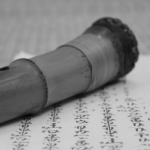 Many Japanese musical instruments are not functional in the same way as Western musical instruments, that is, playing fast, constantly producing large and stable sounds, or composing chords by simultaneously producing multiple sounds. I'm always betting on this one point, the tone. The shamisen sawari (although there is a similar concept to Indian stringed instruments), and the fact that the musicians of folk songs have been particular about playing with silk thread are examples of this tone-oriented appearance.
Many Japanese musical instruments are not functional in the same way as Western musical instruments, that is, playing fast, constantly producing large and stable sounds, or composing chords by simultaneously producing multiple sounds. I'm always betting on this one point, the tone. The shamisen sawari (although there is a similar concept to Indian stringed instruments), and the fact that the musicians of folk songs have been particular about playing with silk thread are examples of this tone-oriented appearance.
再 び Go back to the theme of Japanese musical instruments “tone lovers”. The shamisen “sawari” and the folding musician's commitment to silk are given as examples. The story of Nohkan along with derailment. Speaking of “obtaining a certain pitch with a certain fingering,” Noh tube is no longer an instrument. It is impossible to play a so-called melody in Noh. It is this Noh that is used only to create an atmosphere for describing a scene, beyond the standard of musical instruments. Mr. C. Evert is a teacher at Musashino University because he loves Noh and likes to be a Noh performer, but he cannot fulfill his nationality barrier (they are American men). He often came to listen to concerts in Japanese genres and other genres, and became very close (although I had forgotten all that happened so far). I have been tempted to give him a persistent nobility. At the end, I finally got it out and used it sometimes in studio recordings such as play accompaniment. The super high tone called “Hishigi”, which was peculiar to Noh, did not come out at last. Evert, who is also a master of shakuhachi himself, well understood my interest in the unique existence of Fukizen shakuhachi (classical song) and recommended it to a lecturer at the International Department of Waseda University. Wasn't he the English version of the song “Sumidagawa”?
Another example of commitment is also evident in the fact that the user prefers a monophonic structure rather than moving in a polyphonic direction. According to the shakuhachi instrument, the shakuhachi (“ancient shakuhachi”) of the Shokura-in monument, which is handed down today when used in Gagaku, was originally a six-hole, Western-style seven sound ( It was easy to play the scales of Doremifa, the white key of the piano. Our ancestors changed it over hundreds of years to make it easier to play the pentatonic scale by reducing one note. There is a Zen word called Nozomi, but it seals certain functionality of the instrument based on its own aesthetic sensibility. I chose to be inconvenient. Naturally, the specific gravity (importance) of the sound of each hole increases. Although this may be directly related to the melody, it resulted in good results in timbre pursuit. As for shakuhachi, the fewer holes, the more powerful and attractive the sound is. The ideal is therefore non-porous. However, with this, only the same sound above and below the octave can be played, so we increased the holes one by one and reached today's five-hole shakuhachi (this is called the “dwelling shakuhachi”).
In the shakuhachi, we have used the natural bamboo that is native to Japan.
Today's tuned shakuhachi has been modernized to make a certain volume by coating the interior with a mixture of lacquer and powder so that it can be heard in large halls. . These internal stuffing (which is somewhat different depending on the school and the creator) is called “Gi”, but by adjusting the ground, it is possible to finely adjust the tone and pitch.
[There is also an old-fashioned manufacturing method, that is, a “groundless” tube with a hole in the bamboo and a lacquer applied to the insect repellent. The shakuhachi sound produced by this old-fashioned method may be prized as a bamboo-like, soft and gentle sound in the first place, but obtaining a certain level of compromise is possible only by chance, and a single groundless tube is obtained. This requires a huge amount of bamboo that must be wasted. If you play so-called “music” with the underground pipe, it becomes funky tonk. However, as Fukizen Shakuhachi, you cannot let go of the groundless tube.
For me who played with various Western musical instruments, listened to folk music from all over the world, and went up to the University of Music, it was ridiculous to play with incompletely tuned instruments at first, but there was a connection and Aichi You can lend to the late Prof. Inagaki, in Toyota City, or get some books by relying on the legend, and the composition of the late Mr. Masaharu Fujita, who lives in Hikari City, Yamaguchi Prefecture, since his inception Today, after decades since I was able to give it to a constant, I was completely obsessed with the charm of earthless pipes and only played this. Previously, due to imperfect tuning, the Bach, the Beatles, and various other world songs did not use groundless pipes, but now they are not used because they are afraid. Groundless pipes are legal instruments (tools for religious ceremonies), as they have traditionally been treated rather than musical instruments, and are suitable for the unique style of Fuzen.